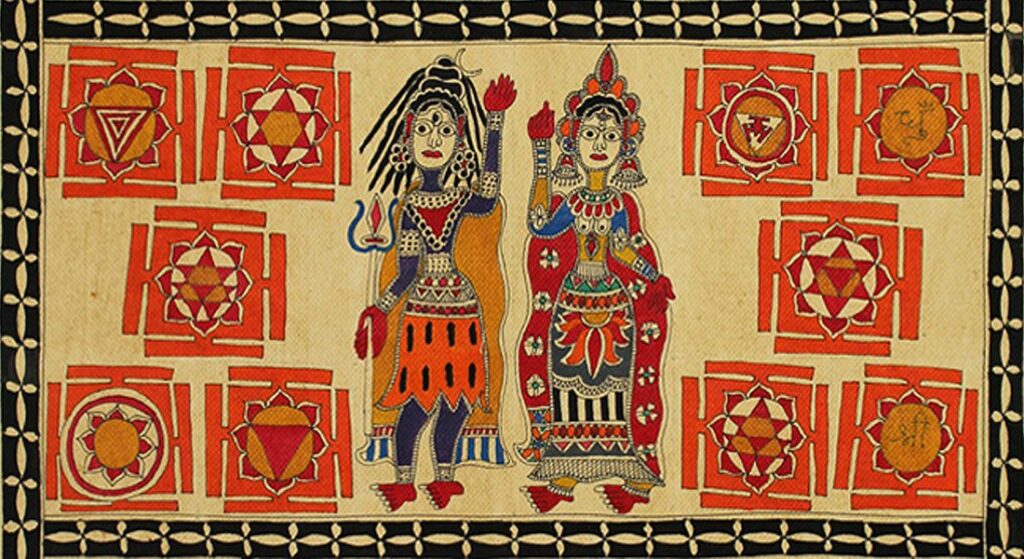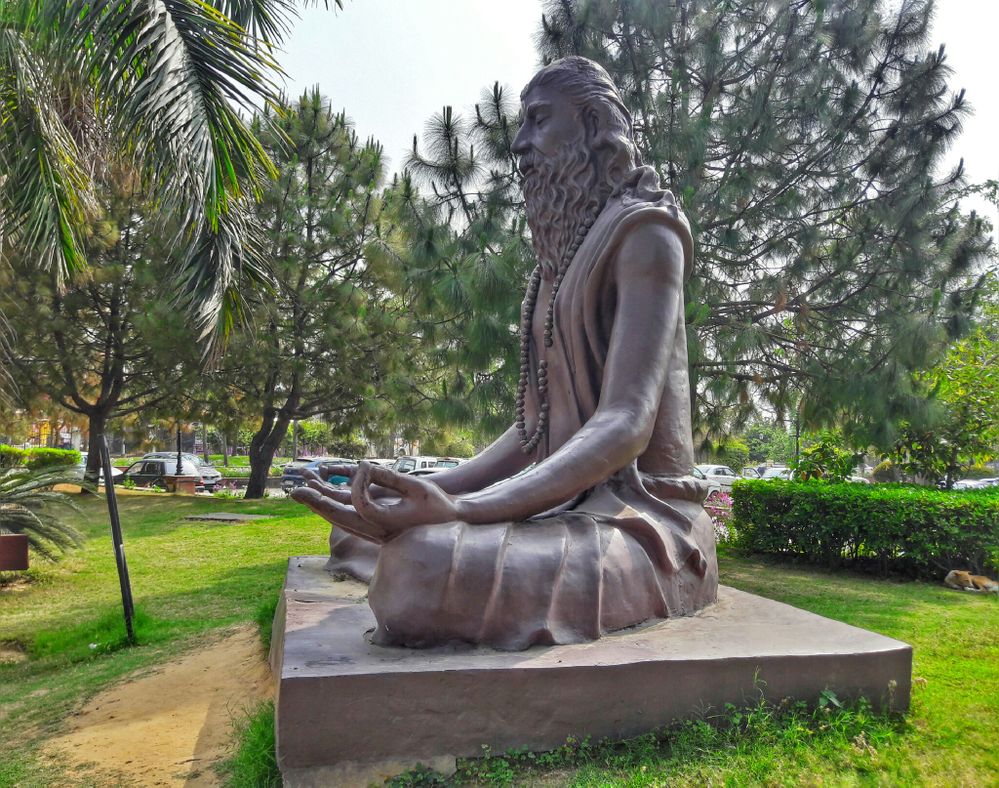Table of Contents
Introduction
In Tantra Yoga, mantras and chanting play significant roles as powerful tools for spiritual growth, transformation, and connecting with higher consciousness. Mantras are sacred sounds, syllables, or phrases that are repeated either silently or aloud, often with rhythmic patterns and specific intonations. Chanting refers to the act of repetitively vocalizing these mantras.
Why Are Mantras So Important in Tantra Yoga?
Mantras are very special and important in Tantra Yoga, and I’ll explain why in a way that second graders can understand.
Imagine you have a secret word or phrase that makes you feel happy, calm, or strong. That’s what a mantra is! It’s like a magical word or sound that helps people feel good and connect with something bigger than themselves.
In Tantra Yoga, people use mantras to help them focus and meditate. Just like how you might close your eyes and take deep breaths to relax, chanting a mantra helps people quiet their minds and feel peaceful inside.
Mantras have special vibrations or energy that can make us feel different emotions or bring positive changes. When we chant a mantra, it’s like we are talking to our own hearts and the universe around us. It helps us feel connected to something greater, like a feeling of love or a sense of peace.
Using mantras in Tantra Yoga can also help us become better and kinder people. When we chant mantras, we can think about qualities like love, compassion, and patience. It’s like training our minds and hearts to be more positive and caring.
Sometimes people use mantras to ask for help or healing. They might chant a specific mantra to feel stronger, to let go of worries, or to find peace during tough times. Mantras can give people hope and remind them that they are not alone.
Mantras are like special tools that help us on our journey of self-discovery and spirituality. They have been used for thousands of years by people who want to connect with their inner selves and find joy and peace.
What Is the Role of Chanting Mantra in Yoga Philosophy?
In yoga philosophy, the practice of chanting mantras holds a significant role and is considered a powerful tool for spiritual growth, self-realization, and union with the divine. Here are some key aspects of the role of chanting mantras in yoga philosophy:

Concentration and Meditation
Chanting mantras helps to focus and concentrate the mind, making it an effective practice for meditation. By repeating a mantra, the mind becomes absorbed in the sound, allowing distractions to fade away and facilitating a state of deep inner stillness and concentration.
Sound and Vibration
In yoga philosophy, it is believed that the universe is made up of vibrations and that everything, including human beings, is composed of vibrational energy. Chanting mantras produces specific sound vibrations that can harmonize and align the practitioner’s energy with the cosmic energy. It is believed that these vibrations have the power to purify the mind, body, and spirit, promoting balance and well-being.
Awakening Higher Consciousness
Mantras are seen as vehicles of divine energy and sacred sound. Chanting mantras is considered a means to connect with higher consciousness and tap into the divine essence within oneself. The repetitive chanting helps to transcend the limitations of the ego-mind and access deeper layers of awareness, leading to spiritual awakening and expanded states of consciousness.
Transformation and Self-Realization
Chanting mantras is believed to have transformative effects on the practitioner. The vibrations generated by the chanting process can help purify and balance the energetic system, dissolve negative patterns, and cultivate positive qualities. This practice can lead to self-realization, the direct experience of one’s true nature and the interconnectedness of all beings.
Integration of Mind, Body, and Spirit
Chanting mantras engages not only the vocal cords but also the breath, creating a harmonious integration of body, mind, and spirit. The combination of sound, breath, and focused intention helps to align these aspects of the self and brings about a sense of wholeness and unity.
What Is the Meaning of Mantra and Tantra?
Mantra: The word “mantra” comes from Sanskrit, an ancient language from India. “Mantra” is made up of two parts: “man” which means “mind” and “tra” which means “instrument” or “tool.” So, when we put them together, “mantra” means “instrument or tool of the mind.”
A mantra is a sacred word, sound, or phrase that is repeated either silently or aloud. It is often used in meditation, prayer, or spiritual practices. Mantras have specific vibrations and are believed to carry spiritual energy. By chanting or repeating mantras, people can focus their minds, connect with their inner selves, and experience a deeper sense of peace, clarity, and spiritual connection.
Tantra: Tantra is a spiritual and philosophical tradition that originated in ancient India. The word “tantra” also comes from Sanskrit and has several meanings, including “weave,” “continuum,” or “expansion.” Tantra is a path or system that seeks to expand and unite various aspects of life, including the spiritual, physical, and energetic dimensions.
In the context of yoga, Tantra is a holistic approach that combines physical postures (asanas), breathwork (pranayama), meditation, mantra chanting, and rituals to awaken and integrate one’s spiritual potential. It embraces the idea that all aspects of life, including the body, mind, and emotions, can be used as tools for spiritual growth and self-realization.
Why Is Mantra Chanting So Powerful?
Mantra chanting is powerful because it helps us in a few special ways:

- Focus and Calm: When we chant a mantra, we have to concentrate on saying it over and over again. This helps our minds to become calm and peaceful. It’s like a magic trick that helps us forget about worries and stay focused on the present moment.
- Positive Energy: Mantras have special vibrations or energy. When we chant a mantra, the sound it creates can make us feel good inside. It’s like listening to a happy song or hearing the sound of waves at the beach.
- Confidence and Strength: Chanting mantras can make us feel strong and brave. It’s like repeating a special phrase that gives us courage. When we chant a mantra, it’s like we are telling ourselves, “I am strong, I am brave, and I can do anything!” It boosts our confidence and helps us face challenges with a positive mindset.
- Connection and Unity: When many people chant the same mantra together, it creates a beautiful sense of togetherness and unity. It’s like singing a song with all your friends or cheering for your favorite team. Chanting mantras together helps us feel connected and supported by others.
- Inner Peace and Happiness: Mantra chanting brings a sense of inner peace and happiness. It helps us let go of worries, feel calm, and find joy within ourselves. It’s like a secret key that unlocks a treasure chest of happiness in our hearts.
What Are The 6 Rules of Chanting?
While there aren’t specific “rules” set in stone for chanting mantras, there are some general guidelines and practices that can enhance the effectiveness of mantra chanting.
Vedic Chanting, which is believed to have been revealed to the ancient Seers of India, follows six important rules. These rules are Varṇa (pronunciation), Svara (chanting notes), Mātrā (duration), Balam (force), Sāma (continuity), and Santāna (conjugation and punctuation). These rules help ensure that Vedic Chanting is done with precision and devotion.
Why Do We Only Chant Mantras 108 Times?
Have you ever noticed that some people use a string of beads called a “mala” while chanting? Well, a mala usually has 108 beads on it, and we chant the mantra once for each bead.
The number 108 is considered sacred and has a lot of significance in Hindu cultures and spiritual practices. It is considered sacred and has a deep meaning. Here are a few reasons why we chant a mantra 108 times:

Sacred Mathematics
In ancient times, people discovered that the number 108 has special mathematical properties. For example, 108 is divisible by many numbers: 1, 2, 3, 4, 6, 9, 12, 18, 27, 36, and 54. This divisibility is believed to symbolize the interconnectedness of everything in the universe.
Cosmic and Astronomical Connections
The number 108 is related to celestial bodies and their distances. For instance, the average distance between the Earth and the Sun is about 108 times the Sun’s diameter. Additionally, there are said to be 108 energy lines converging to form the heart chakra, the center of spiritual energy within us.
How Do You Know If a Mantra Is Working?
Knowing if a mantra is working can be a subjective experience, as it varies from person to person. Indicators of a positive impact include experiencing increased inner peace, reduced stress and anxiety, improved focus and concentration, emotional stability, spiritual growth, and positive life changes.
These signs suggest that the mantra is positively influencing well-being, emotional state, spiritual connection, and overall personal growth. It’s important to remember that individual experiences may differ, and trusting your own observations and feelings is key in assessing the effectiveness of a mantra for you.
Can I Chant Mantra Anytime and Anywhere?
Yes, you can chant a mantra anytime and anywhere. Mantras can be practiced in various settings and situations, as their power and effectiveness are not limited to specific times or places.
Chanting mantras can be incorporated into various aspects of daily life. Starting the day with a mantra sets a positive tone, while evening chanting promotes relaxation. Mantras are commonly used during meditation, enhancing concentration and fostering a meditative state. Integrating mantra repetition into daily routines brings mindfulness and calmness.
During stressful situations, silently chanting a mantra can provide peace and perspective. Mantra chanting during commuting or traveling creates a serene inner space amidst busyness. Additionally, sacred spaces like temples or nature settings enhance the impact of mantra practice.
Conclusion
In conclusion, chanting mantras plays a significant role in Tantra Yoga. Mantras are sacred sounds or phrases that have been used for centuries as tools for spiritual growth, meditation, and self-transformation. In Tantra Yoga, chanting mantras is believed to harness and channel divine energy, awaken higher consciousness, and connect with the divine within oneself and the universe.
The vibrations and resonance created by chanting mantras are thought to stimulate and balance the chakras, the subtle energy centers in the body. It is a powerful practice that allows individuals to cultivate a deeper sense of connection, awareness, and harmony within themselves and their surroundings.
References
- Shankarnarayanan, S (1972). The Ten Great Cosmic Powers: Dasa Mahavidyas (4 ed.). Chennai: Samata Books. pp. 4–5. ISBN 9788185208381.
- Kinsley (1997) p. 302
- Daniélou, Alain (1991). The Myths and Gods of India: The Classic Work on Hindu Polytheism from the Princeton Bollingen Series. Inner Traditions / Bear & Co. pp. 284–290. ISBN 978-0-89281-354-4.
- Kinsley, David R (1987). Hindu Goddesses: Vision of the Divine Feminine in the Hindu Religious Tradition. Motilal Banarsidass Publication. pp. 161–165. ISBN 9788120803947.
